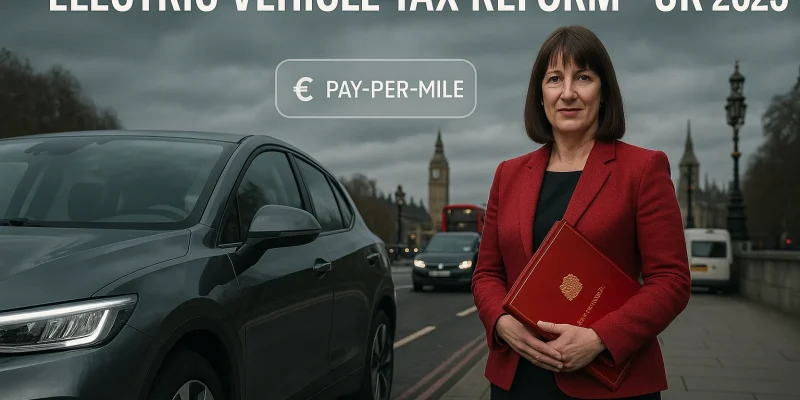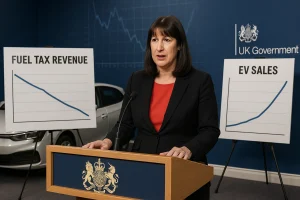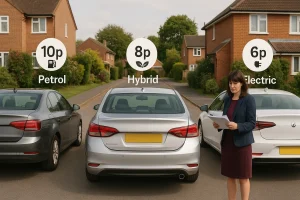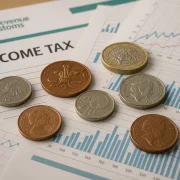
Rachel Reeves Electric Vehicle Tax: Pay-Per-Mile Plan Set to Reshape UK Motoring
As the UK accelerates its transition to a net-zero future, the shift from petrol and diesel vehicles to electric vehicles (EVs) is gathering pace.
However, this shift poses a new challenge to the Treasury’s longstanding reliance on fuel duty for public revenue.
In response, Chancellor Rachel Reeves is expected to announce a pay-per-mile road tax for EVs, a move aimed at bridging a growing fiscal gap while promoting fairness among all drivers.
This policy marks a pivotal moment in how Britain may choose to fund its road infrastructure in a post-combustion engine era.
Why Is Rachel Reeves Proposing A Pay-Per-Mile Tax For Electric Vehicles?

The proposal for a pay-per-mile tax on electric vehicles (EVs) is driven by the Treasury’s concern over the steady decline in fuel duty revenues.
As EV adoption grows, fewer motorists are paying fuel duty, which traditionally provides billions of pounds annually for the government.
Without a replacement revenue stream, public finances face a significant gap in funding for transport infrastructure and public services.
Rachel Reeves, as Chancellor, is expected to address this issue by implementing a fair contribution system for all drivers.
The proposed per-mile charge is designed to ensure that electric vehicle owners contribute proportionately to the costs of road maintenance and infrastructure development.
Key motivations behind this tax include:
- Offsetting the loss of revenue caused by the phase-out of petrol and diesel vehicles
- Ensuring financial sustainability of transport and infrastructure budgets
- Maintaining equity between conventional and electric vehicle owners
- Supporting long-term environmental and fiscal balance within UK motoring policy
According to Treasury projections, the introduction of this plan could raise approximately £1.8 billion annually by the early 2030s, helping to reduce the estimated £20–£30 billion fiscal shortfall expected by the end of the current Parliament.
How Much Could Electric Vehicle Drivers Expect To Pay Under The New Plan?
Electric vehicle drivers may face charges of around 3 pence per mile under the proposed system.
For the average UK motorist driving approximately 8,000 miles per year, this would translate to an additional £240 to £250 annually.
While this may appear significant, it remains considerably lower than what traditional car owners currently pay in fuel duty.
Petrol and diesel drivers spend roughly £600 each year on average in fuel-related taxation.
To provide a clear comparison, the following table outlines estimated annual costs under the proposed system:
| Vehicle Type | Average Annual Mileage | Tax or Duty Type | Estimated Annual Cost |
| Petrol Car | 8,000 miles | Fuel Duty | £600 |
| Diesel Car | 8,000 miles | Fuel Duty | £580 |
| Electric Car | 8,000 miles | Per-Mile Charge (3p) | £240 |
| Hybrid Car | 8,000 miles | Reduced Per-Mile Charge | £150–£200 |
The Treasury has indicated that hybrid vehicles will continue to benefit from lower charges as they still rely partially on fuel, ensuring that the overall taxation reflects actual carbon emissions and road use levels.
When Will The EV Road Charges Potentially Come Into Effect?
The new electric vehicle tax framework is expected to be officially announced during the November 2025 Budget, followed by a period of public consultation.
This consultation will allow stakeholders, including motoring organisations, environmental groups, and industry representatives, to provide feedback on the proposed structure.
If approved, the system could come into effect by 2028, providing a transitional period for both the government and drivers to prepare for the new method of road taxation.
During this time, the Treasury will likely collaborate with technology providers and the DVLA to develop a reliable system for recording and managing mileage declarations.
The expected timeline:
- November 2025: Policy announcement and Budget presentation
- 2026–2027: Public consultation and system design
- 2028: Initial implementation phase
- 2030 onwards: Full adoption and integration with other motoring taxes
What Does The Mileage-Based Tax Mean For Hybrid Car Owners?

Hybrid car owners will experience a differentiated approach within the new taxation structure.
Since hybrids use a combination of electricity and traditional fuel, they produce lower emissions than conventional vehicles but still benefit from the road network funded by taxation.
The government plans to set reduced per-mile rates for hybrid vehicles to maintain fairness. This structure is designed to continue encouraging partial electrification while gradually transitioning to full electric mobility.
Potential implications for hybrid vehicle owners include:
- Continued eligibility for certain green vehicle incentives
- Gradual phase-in of higher rates as hybrid models evolve
- Adjusted rates based on fuel efficiency and electric range
- Reassessment of tax rates every fiscal year to align with emissions data
This graduated system reflects the government’s intention to balance fairness with sustainability, ensuring that all motorists contribute according to their vehicle’s environmental impact.
How Will The UK Government Track Or Estimate Mileage For Taxation?
Tracking or estimating vehicle mileage presents one of the most complex aspects of the new tax framework.
To address privacy concerns and avoid costly infrastructure changes, the government intends to adopt a self-declaration and verification system rather than real-time tracking.
Under this plan:
- Drivers will declare their expected annual mileage when renewing vehicle tax.
- Payments will be based on the estimated usage.
- If a driver exceeds their declared mileage, they will pay a top-up charge at the end of the year.
- Drivers who travel fewer miles may roll over unused mileage into the following year.
Verification could be supported through MOT test data, which already records odometer readings. This approach allows the system to remain transparent and efficient without introducing surveillance technologies.
The following table highlights the proposed operational model:
| Stage | Activity | Responsibility | Verification Method |
| Annual Declaration | Estimate of mileage submitted | Vehicle Owner | Online DVLA Portal |
| Payment | Initial payment based on estimate | Vehicle Owner | Automatic Billing |
| Review | Actual mileage verified during MOT | DVLA / MOT Centres | Odometer Reading |
| Adjustment | Refund or top-up based on variance | Treasury | Annual Reconciliation |
This method maintains a balance between practicality and data protection, avoiding the concerns associated with real-time GPS monitoring.
How Is The Government Justifying The Shift In EV Taxation?
The Treasury has justified the introduction of the EV mileage tax as part of a broader commitment to fairness, fiscal responsibility, and sustainability.
While electric vehicles are essential to the UK’s carbon reduction goals, they also bypass existing taxation mechanisms, creating inequality between motorists.
A government spokesperson recently stated that “a fairer system for all drivers” is needed to maintain the road network and public services.
The Treasury has already invested £4 billion in EV infrastructure, including charging points and grants of up to £3,750 per eligible vehicle, to support drivers transitioning away from fossil fuels.
The justification focuses on three main principles:
- Equity: Ensuring EV owners contribute fairly alongside petrol and diesel drivers
- Sustainability: Guaranteeing long-term funding for roads and infrastructure
- Practicality: Implementing a system that complements rather than hinders EV growth
The government also stresses that the per-mile charge remains significantly lower than traditional fuel taxes, preserving cost advantages for EV owners while ensuring the sustainability of public funding.
What Are The Political Reactions And Public Concerns Around The Policy?

The announcement has sparked intense political debate and public reaction. Supporters argue that the policy is necessary to maintain public finances and fund the UK’s infrastructure as the automotive industry transitions toward electrification. Critics, however, claim it could undermine progress toward net-zero targets.
Sir Mel Stride, shadow chancellor, criticised the move, suggesting it unfairly targets commuters and car owners to fill a fiscal gap.
This sentiment reflects wider concerns among motorists that EV ownership could become less financially appealing.
Public opinion remains divided. Some argue that paying per mile is a transparent and fair way to manage road funding.
Others worry that the new charges will discourage EV purchases, especially among middle-income families who have only recently begun transitioning to electric mobility.
The Office for Budget Responsibility (OBR) has also noted that successive governments’ fuel duty freezes since 2010 have cost the Treasury nearly £100 billion, intensifying the need for new funding mechanisms.
What Does This Mean For The Future Of EV Adoption In The UK?
The introduction of a per-mile tax will likely influence the pace of electric vehicle adoption in multiple ways.
While it establishes a long-term financial framework for maintaining roads, it could also affect consumer perception of electric cars as a cost-effective alternative to petrol and diesel vehicles.
To mitigate this impact, the government is considering complementary measures such as:
- Maintaining existing EV grants for new car buyers
- Expanding access to affordable charging stations across the country
- Offering tax relief for home charging infrastructure installations
- Providing additional support for fleet operators transitioning to electric
Industry experts suggest that these measures will be critical to ensuring that the new taxation system does not hinder the UK’s broader net-zero objectives.
The government’s ability to communicate the fairness and necessity of the new plan will determine its long-term success in sustaining both EV growth and public revenue.
How Does This Pay-Per-Mile Plan Compare To International Models?

Mileage-based road taxation is already being implemented or tested in several countries facing similar challenges.
The UK’s proposed framework draws inspiration from these international examples while adapting to domestic needs.
- The Netherlands operates a road pricing system that calculates tax based on vehicle type, time of travel, and distance covered, encouraging off-peak driving and efficient use of roads.
- Oregon and Utah in the United States have introduced voluntary “road usage charge” schemes, allowing drivers to pay based on distance rather than fuel consumption.
- Germany applies distance-based tolls primarily to heavy goods vehicles, linking charges to emissions and vehicle weight.
These international examples demonstrate that mileage-based taxation can be an effective way to replace fuel duty in an electrified transport economy. The UK’s approach, which relies on self-declared mileage and MOT verification, may be simpler but less dynamic compared to more advanced digital toll systems. However, it offers a practical and privacy-conscious starting point for a future-proof road funding model.
Conclusion
The proposed pay-per-mile tax for electric vehicles represents a fundamental shift in the way the UK funds its road infrastructure. Rachel Reeves’ policy is shaped by economic necessity, technological change, and environmental priorities.
While it raises valid concerns among motorists and environmental advocates, it also opens the door to a more sustainable and equitable future in public finance. The upcoming consultation period will be critical in refining the policy, addressing public concerns, and ensuring it aligns with the UK’s green transport ambitions.
As electric vehicles become the new norm, it is clear that the methods for funding and managing Britain’s roads must evolve with them.
Frequently Asked Questions
What is the main reason for introducing a mileage-based EV tax?
The government expects a significant drop in revenue from fuel duty as EV adoption increases. The mileage-based tax aims to replace this lost income and ensure that all road users contribute fairly to road maintenance and public services.
Will this tax apply to all electric vehicle owners?
Yes, the plan will cover all electric vehicle drivers, although implementation may be phased and start with new vehicle registrations or higher-mileage users.
How will mileage be tracked without using GPS?
Drivers will declare their expected annual mileage and pay a corresponding fee. If they exceed this mileage, they may pay a top-up. If they drive less, unused miles can be rolled over into the next year.
Is this policy already confirmed?
The policy is expected to be outlined in the 26 November Budget. It is not yet final and will be subject to public consultation and legislative processes, with implementation likely starting in 2028.
How will this impact the cost of owning an EV?
While EVs remain cheaper to maintain and fuel than traditional cars, the new tax introduces an additional annual cost. However, it is still expected to be lower than current fuel duty costs for ICE vehicles.
What support measures are being considered for EV owners?
The government has hinted at further support, including grants and investment in charging infrastructure, to ensure the continued attractiveness of electric vehicle ownership.
Do other countries have similar EV road tax systems?
Yes, countries like the Netherlands and regions in the US have introduced or tested mileage-based taxation to replace falling fuel tax revenues and fund road networks sustainably.





